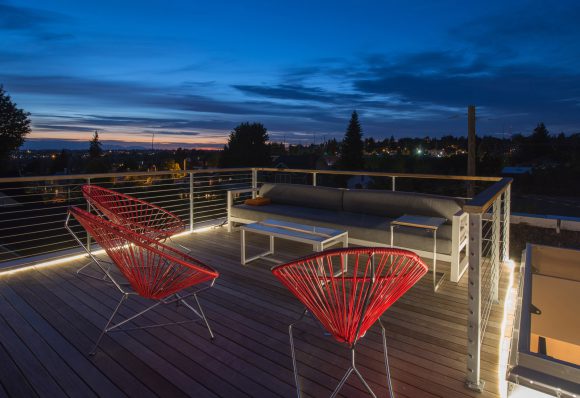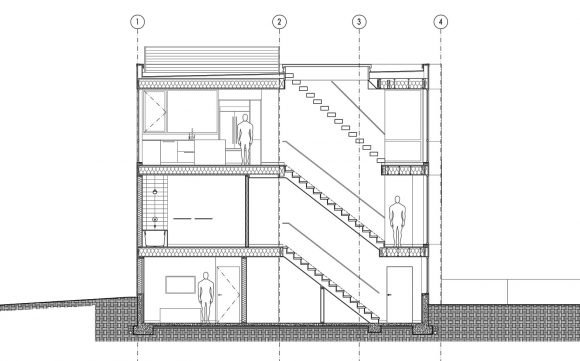
[All images by BUILD LLC]
As density within our cities continues to increase, our constant reach for daylight and view, and the continued success of the reverse floor plan, roof terraces are a frequent architectural element in the designs here at BUILD. We’ve included enough rooftop terraces in our projects that we’ve got a bag of tricks, a handful of lessons learned, and a portfolio worth of photos to share. Our knowledge and experience on these highly enjoyable spaces can be condensed down to 5 simple points for single family residences. Here goes:
1. Keep the roof terrace to under 200 square feet.
There is a key phrase within the Washington State Amendments to the International Building Code (2012 IBC 1009.18) that allows an accessible rooftop of less than 200 square feet in area to be accessed by a ship ladder rather than a fully code-compliant stairway. This is an important exception as a full stairway to the roof would require more length than what is typically allotted to the other stairways in the house, subsequently the stair to the roof wouldn’t fit within the opening of the stair core serving the floors below. This is primarily because of the added height of the roof assembly and the fact that the upper floor is typically a bit taller in the reverse floor plan designs. Both of these require a stair of significant height to reach the roof. In addition to the geometrical constraints, most homes don’t need a full stairway to the roof terrace anyway. Fewer individuals may be using the roof terrace on a regular basis and because the rooftop terrace is often seasonal, its use is more limited. When it comes to ship ladders, the building code has fewer limitations around the tread geometry and handrail/guardrail design. Because of these factors, ship ladders tend to be more cost effective and have less of a visual impact. Despite all of these liberties, however, the ship ladders to roof terraces still need to be perfectly safe, and the code simply puts the discretion in the hands of the architectural team. At BUILD we design something that falls between a stairway and a ship ladder. We like the more generous tread and riser geometry of a stairway with the minimalism and efficiency of a ship ladder. It’s also desirable to match the material palette of the ship ladder to the stairs in the house.

2. Stack the ship ladder with the stairs.
Assuming that the residence is more than one level, typically around 40 square feet of area has already been dedicated to vertical circulation. It makes the most sense to locate the ship ladder to the roof terrace within this stair core, otherwise valuable floor area will get taken up to accomodate the rooftop access. In many of our reverse floor plan designs, the top floor is important for gathering and entertaining, and aligning all of the vertical circulation benefits the overall plan.

3. Specify the roof hatch early.
There aren’t nearly the number of options with roof hatches as with other types of doors in a residence. With manufacturers, hatch sizes, and opening mechanisms rather limited, this piece should be selected during the design development phase of a project and planned around early. We specify a commercial grade, thermally broken, Type L-50TB roof hatch door by Bilco. It’s an excellent, long hatch that keeps the water out and the heat in, all while staying on course with the modernism of our designs. With any of these roof hatches, regardless of manufacturer, special attention should be paid to their prefabricated dimensions. Because they rarely come in sizes that accommodate a typical residential ship ladder/stair opening, the position of the hatch should be carefully considered to minimize head-bumping conditions and odd drywall notches. Consideration should also be given to the location of the handle and closing mechanism of the hatch as it will need to be within easy reach from the ship ladder.


4. Float the terrace structure.
A modern day flat roof isn’t, of course, truly flat (they’re typically sloped ¼” per foot), but they’re flat enough to construct a terrace structure on top. We use a single ply roof membrane on our flat roofs which allows for easy addition of the roof terrace. The joists (or sleepers) for the terrace structure are cut to the same slope as the roof in the opposite direction so that the resulting geometry is perfectly flat. Rather than the roof terrace structure fastening to the roof, it simply floats on top, held down by its own weight. This eliminates any punctures at the roof membrane and keeps the terrace structure independent and straight-forward to construct.

5. Use simple, low-maintenance materials.
A luxury item like a roof terrace should be exactly that, luxurious. It should be enjoyable when the weather’s nice and should disappear from sight and mind when it’s not. Very few homeowners want to add an enjoyable design element to their residence just to bring a maintenance issue to their already busy lives. For this reason, we use natural ipe decking at the roof terrace as it weathers to a handsome silver over time and requires only an annual anti-bacterial cleaning (30 minutes with a solution and a brush). We like to use galvanized steel verticals with horizontal stainless steel cable rails as both require zero maintenance. For added visual enjoyment at the roof, we sometimes install a green roof adjacent to the roof terrace. For low-maintenance reasons, our current favorite is the pre-vegetated mat system by Xero Flora.
When designed with intention and thought, a roof terrace adds an entire room’s worth of function to a residence. The increased height captures more daylight and view, while maintaining privacy as the roof terraces on modern homes are usually perched above the traditional gable roofs of adjacent houses. We’re huge fans of the roof terrace, and you’ll continue to see this architectural element designed into our projects using the set of guidelines above.
Cheers from Team BUILD





